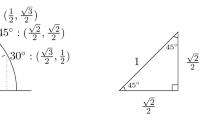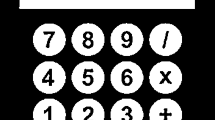Abstract
Purpose
In this article, we aim to present and defend a contextual approach to mathematical explanation.
Method
To do this, we introduce an epistemic reading of mathematical explanation.
Results
The epistemic reading not only clarifies the link between mathematical explanation and mathematical understanding, but also allows us to explicate some contextual factors governing explanation. We then show how several accounts of mathematical explanation can be read in this approach.
Conclusion
The contextual approach defended here clears up the notion of explanation and pushes us (at least for now) towards a pluralist vision on mathematical explanation.
Similar content being viewed by others
Notes
See, for example, Craver (2014: p. 40).
As inspired by Khalifa (2016).
We use ‘agent’ in a broad enough sense to include all entities with non-trivial mathematical intentions and actions, being they a single human mathematician, a cooperative community or a sophisticated automated theorem prover.
This leads to the following difference between the two: While understanding is the possession of abilities, explanation is the message that transfers them. This implies that having an explanation leads to understanding (for agent S), but does not imply the converse. An agent who understands will have the abilities granted by an explanation, but does not necessarily have an explanation (at least in the message-ready sense, although the substance is certainly present).
We call the contextual factor K without mention of P because the sentence under consideration is ‘Proof P explains theorem t’, which holds P constant. If the sentence was ‘Theorem t is explained’, then the couple (P,K) would be the contextual factor.
There are different ways by which domains can be differentiated, e.g. by historically, by school of thought, by mathematical subdisciplines.
If epistemic interests can differ, we have an additional reason why different proofs can, contextually, be of explanatory value—namely that they render abilities belonging to different epistemic interests.
An exhaustive list, if possible, would include the ability to (re)construct a proof of the theorem, but, with the following list, we wish to draw focus on the abilities beyond justification.
See, for example, van Fraassen’s (1980) pragmatic theory of explanation.
For an interesting overview on the status of visualization in historical periods of logic and mathematics, see Mancosu (2005).
See Weierstrass’ letter to his colleague Schwarz, cited from Bottazzini (2001).
Not to be confused with Cellucci’s use of the term analytic.
A calculator number is here a six-digit number that is constructed by taking the three digits on any row, column or main diagonal of the keyboard in forward and then reverse order. For the detailed overview of this case, see (Lange 2014: pp. 487–489).
The property here is being divisible by 37.
See Weber et al (2013) for a similar argument about pluralism towards scientific explanation.
For a discussion about the value of both an analytical and reflective approach to mathematical explanation, see Weber and Frans (2016).
In this paper, we only treated the type of understanding corresponding with a type of explanation, namely understanding why the theorem is true. However, since epistemic interests are also interests about a ‘type’ of abilities, they could also be called a type of understanding, but the object of understanding is different. If required, one could distinguish between explanatory understanding (E/U) and understanding what is of epistemic interest (I/U). We may find other valuable ways to delineate a kind of understanding, but those are outside the scope of our exploration here.
Furthermore, different proofs (P, P′, etc) may attain the same abilities (U) for different (or even the same) agents.
References
Avigad, J. (2008). Understanding proof. In P. Mancosu (Ed.), The philosophy of mathematical practice (pp. 317–353). New York: Oxford University Press.
Bottazzini, U. (2001). From Paris to Berlin: Contrasted images of nineteenth-century mathematics. In U. Bottazzini, & A. Dahan-Dalmédico (Eds.), Changing images in mathematics: From the French revolution to the new millennium (pp. 31–47). London: Rougledge.
Cellucci, C. (2008). The nature of mathematical explanation. Studies in History and Philosophy of Science Part A, 39(2), 202–210.
Corry, L. (2012). Modern algebra and the rise of mathematical structures. Boston: Birkhäuser.
Craver, C. F. (2014). The ontic account of scientific explanation. In M. I. Kaiser, O. R. Scholz, D. Plenge, et al. (Eds.), Explanation in the special sciences (pp. 27–52). Dordrecht: Springer.
de Regt, H. W., & Dieks, D. (2005). A contextual approach to scientific understanding. Synthese, 144, 137–170.
Devlin, K. J. (2000). The math gene: How mathematical thinking evolved and why numbers are like gossip. New York: Basic Books.
Edgar, G. A. (1993). Classics on fractals. Reading, MA: Addison-Wesley Publishing Company.
Eilenberg, S., & MacLane, S. (1945). General theory of natural equivalences. Transactions of the American Mathematical Society, 58(2), 231–294.
Ferreirós, J. (2007). The rise of pure mathematics as arithmetic with Gauss. In C. Goldstein, N. Schappacher, & J. Schwermer (Eds.), The shaping of arithmetic after CF Gauss’s disquisitiones arithmeticae (pp. 235–268). Dordrecht: Springer.
Hacking, I. (1992). ‘Style’ for historians and philosophers. Studies in History and Philosophy of Science Part A, 23(1), 1–20.
Hafner, J., & Mancosu, P. (2005). The varieties of mathematical explanation. In P. Mancosu, K. F. Jørgensen, & S. A. Pedersen (Eds.), Visualization, explanation and reasoning styles in mathematics (pp. 215–250). Dordrecht: Springer.
Hempel, C. (1965). Aspects of scientific explanation and other essays in the philosophy of science. New York: Free Press.
Khalifa, K. (2016). khaliphilosophy: Ontic, Epistemic, and Pragmatic Models of Explanation. [Blog post] Retrieved from http://khaliphilosophy.blogspot.com/2016/03/ontic-epistemic-and-pragmatic-models-of.html.
Lange, M. (2014). Aspects of mathematical explanation: Symmetry, unity, and salience. Philosophical Review, 123(4), 485–531.
Mancosu, P. (2005). Visualization in logic and mathematics. In P. Mancosu, K. F. Jørgensen, & S. A. Pedersen (Eds.), Visualization, explanation and reasoning styles in mathematics (pp. 13–30). Dordrecht: Springer.
Mancosu, P. (2008). Mathematical explanation: Why it matters. In P. Mancosu (Ed.), The philosophy of mathematical practice (pp. 134–149). Oxford: University Press.
Mancosu, P. (2010). Mathematical style. In E. N. Zalta (Ed.), The Stanford Encyclopedia of philosophy (Spring 2010 Edition). Retrieved from http://plato.stanford.edu/archives/spr2010/entries/mathematical-style/.
Pincock, C. (2015). The unsolvability of the quintic: A case study in abstract mathematical explanation. Philosopher’s Imprint, 15(3), 1–19.
Reck, E. H. (2009). Dedekind, structural reasoning, and mathematical understanding. In B. Van Kerkove (Ed.), New perspectives on mathematical practices: Essays in philosophy and history of mathematics (pp. 150–173). Singapore: World Scientific.
Salmon, W. C. (1984). Scientific explanation: Three basic conceptions. In PSA: Proceedings of the biennial meeting of the philosophy of science association (Vol. 1984, No. 2, pp. 293–305). Philosophy of Science Association.
Sierpinska, A. (1994). Understanding in mathematics. London: The Falmer Press.
Steiner, M. (1978). Mathematical explanation. Philosophical Studies, 34(2), 135–151.
Trout, J. D. (2002). Scientific explanation and the sense of understanding. Philosophy of Science, 69(2), 212–233.
Trout, J. D. (2005). Paying the price for a theory of explanation: de Regt’s discussion of Trout. Philosophy of Science, 72(1), 198–208.
Van Fraassen, B. C. (1980). The scientific image. Oxford: Oxford University Press.
Waskan, J. (2011). Intelligibility and the cape: Combatting anti-psychologism about explanation. In Epistemology of modeling & simulation: Building research bridges between the philosophical and modeling communities. Pittsburgh. Retrieved from http://philsci-archive.pitt.edu/8530/.
Weber, E., & Frans, J. (2016). Is mathematics for domain for philosophers of explanation? Journal for General Philosophy of Science. doi:10.1007/s10838-016-9332-1.
Weber, E., Van Bouwel, J., & De Vreese, L. (2013). Scientific explanation. Dordrecht: Springer.
Weber, E., & Verhoeven, L. (2002). Explanatory proofs in mathematics. Logique et Analyse, 45(179–180), 299–307.
Wilkenfeld, D. A. (2013). Explaining and understanding. Doctoral thesis, The Ohio State University.
Acknowledgements
The authors thank an anonymous referee for some very helpful comments. The first two authors are indebted to the Fund for Scientific Reseach—Flanders, of which they are PhD fellows (project 1158617N and project 11M9214N respectively). All authors would also like to acknowledge the support of VUB research project SRP22: Logic and Philosophy of Mathematical Practices.
Author information
Authors and Affiliations
Corresponding author
Rights and permissions
About this article
Cite this article
Delarivière, S., Frans, J. & Van Kerkhove, B. Mathematical Explanation: A Contextual Approach. J. Indian Counc. Philos. Res. 34, 309–329 (2017). https://doi.org/10.1007/s40961-016-0086-2
Received:
Revised:
Accepted:
Published:
Issue Date:
DOI: https://doi.org/10.1007/s40961-016-0086-2




